Appy Entertainment put all the pieces in place for runaway success as an iPhone developer. Now if their number one customer would just keep noticing.
By Meelad Sadat
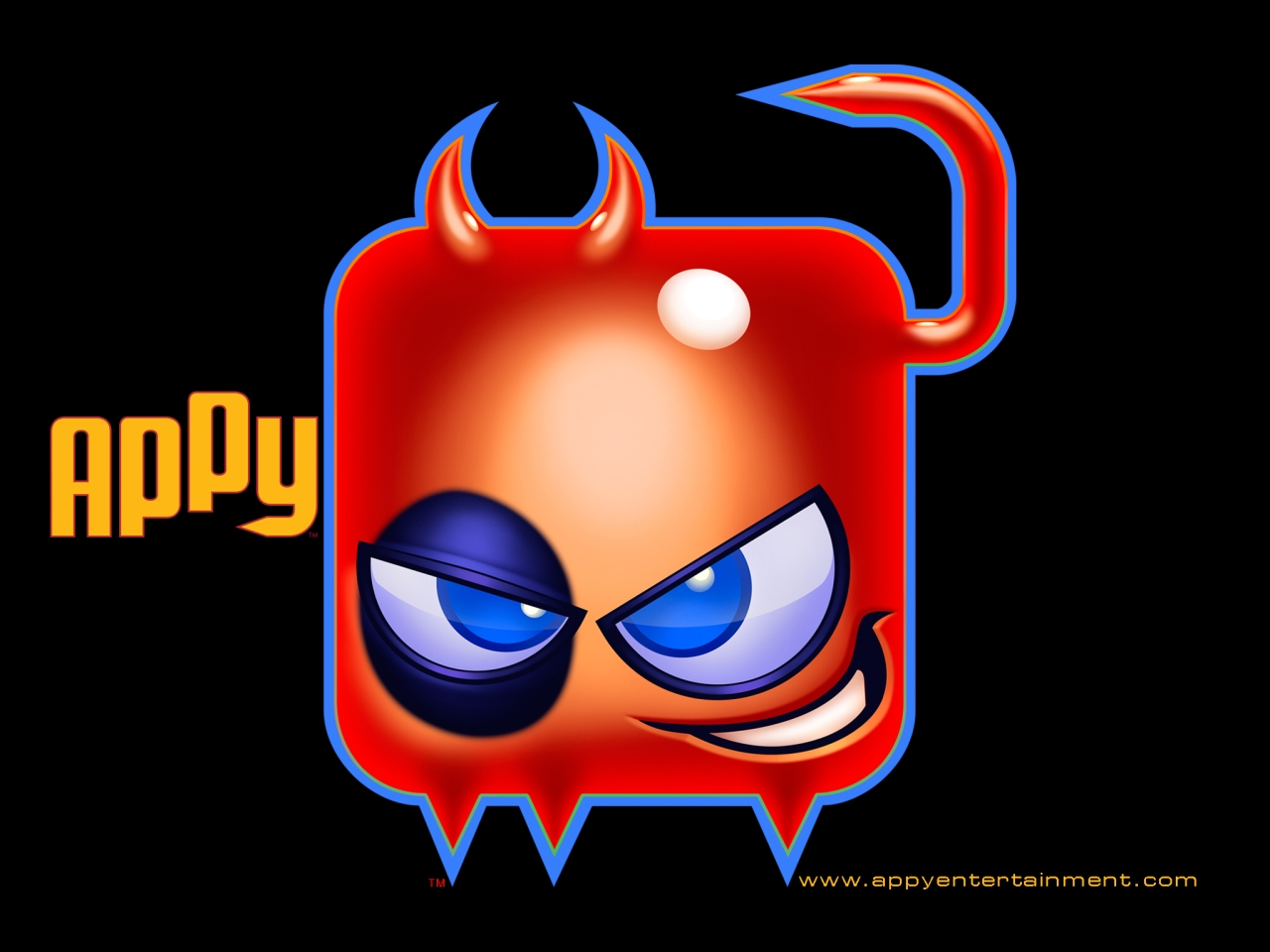
It doesn’t take long for Appy Entertainment’s Paul O’Connor to turn the conversation to Apple. It’s understandable. Appy is an independent iPhone app maker. That’s all they do. That makes Apple their publisher and their retailer. As Appy’s brand director, Paul spends a lot of time thinking about them.
“I call Apple the Kremlin,” Paul says. “They’re very secretive.”
He also calls Apple his number one customer.
Apple’s success with iPhone and iPod Touch is common knowledge at this point, mostly because the company doesn’t hesitate to quantify it. Apple says it has sold at about 50 million of the devices worldwide. It was 40 million in June. This summer they announced that downloads at the App Store surpassed the 2 billion mark. That milestone might have taken even Apple by surprise. The simple announcement contrasted the fanfare that it built up to mark 1 billion downloads, where it gave its billionth customer a backpack full of pricey Apple hardware. That had taken place only about five months before. This week the company trumpeted another milestone, where strangely enough the number of apps in the App Store also doubled in about five months. There are now more than 100,000 apps available to iPhone and iPod users. That’s a hundred thousand unique pieces of software for mobile games, utility and everything in between, and much of it for free. That’s the marketplace where Appy is competing.
Appy started up just a little over a year ago and is completely self-funded. Among the five founders, four including Paul are game developers who spent the majority of their careers creating feature loaded, time-gobbling console and PC games. And they were good at it. Paul along with co-founders Chris Ulm and Farzad Varahramyan led design and visual direction on Lorne Lanning’s first three Oddworld games. Emmanuel Valdez was behind Midway’s bestselling boxing franchise Ready2Rumble. The fifth founder is Rick Olafsson, who was previously CFO of console game developer High Moon Studios. In fact all of Appy, including their production staff, were among the startup team and early hires that helped build High Moon before it became an Activision studio. Throughout their experience, they saw the evolution of videogames into ‘appointment experiences’ where players have to block off hours at a time to enjoy a gaming session.
Appy recognized a very different, and potentially a very hefty opportunity for games on iPhone. Here was a suddenly huge install base for a robust mobile computing platform, and by all accounts one made up of a game savvy audience. As a game platform, the layers between creators and consumers needed for a $60 packaged good were gone. Product development cycles were months or even weeks, compared to two years or more for console games. Consumer feedback was instant, and nearly instantly addressable.
“We thought there was an opportunity for a different type of game on iPhone,” says Paul. “All of our ideas from the very beginning were based on the underpinnings of what made the iPhone different. The iPhone is cool, it’s a status symbol. People want to share it, and they want something on it to share.”
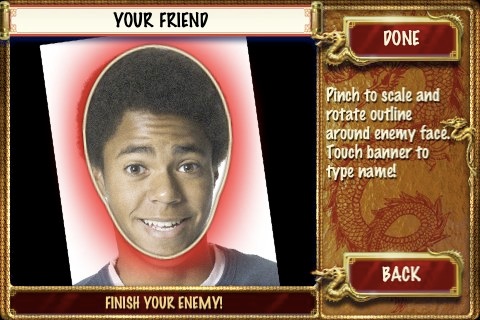 Appy Entertainment’s “Face Fighter”
Appy Entertainment’s “Face Fighter”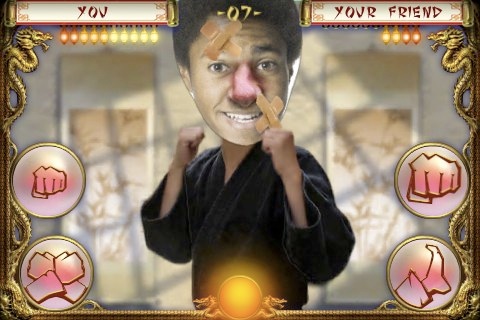
Paul refines the concept with the phrase ‘compulsively sharable’ to describe what types of games do well on iPhone. It’s a view that sees the iPhone and most of its users as a show and tell platform. The key is to give them something to show off. Another core concept for Appy is that games need to reflect a game play attribute they label as 5-500. An iPhone game has to be an experience that feels complete in about 5 minutes of playtime, but is compelling enough to want to come back to 500 times or more.
That’s Appy’s blueprint for creating game apps. And Appy is big on blueprints, with something akin to a style guide that extends from the types of products they make to their efforts at creating a memorable developer brand. That was first order of business for Appy. They didn’t just slap a name on the company to get cracking on product. From the get-go they set out to create a developer brand with personality, something that would speak to their eventual consumers.
“We wanted to draw from Apple’s branding,” Paul says. “We also wanted to prepare for the extended development period before the first title, when we were live and trying to build a base but we couldn’t talk about what we were doing. All we had to talk about was our name, and our attitude.”
Appy has one of the best visual designers in the business in Farzad Varahramyan. Farzad was behind much of the art direction in the visually rich universe of Lanning’s Oddworld games. At High Moon, he was responsible for the warped vampire Western universe of the studio’s first game, “Darkwatch.” For its moderate commercial success, “Darkwatch” garnered an impressive amount of recognition for art direction and visual design, including numerous awards. Farzad’s visual design resume extends from games into films such as “AVP: Alien vs. Predator” and “Jumanji.” There’s a lengthy blog on Appy’s web site about the process that Farzad put into the studio’s logo.
“We wanted a clear symbol that could be animated. Our character had to be easy to remember, with a distinctive silhouette,” Farzad says in the blog. “I started exploring bringing the [iPhone] button shape itself to life. He had to be something a college student would wear on a shirt. We also wanted a shape that was simple enough for anyone to draw.”
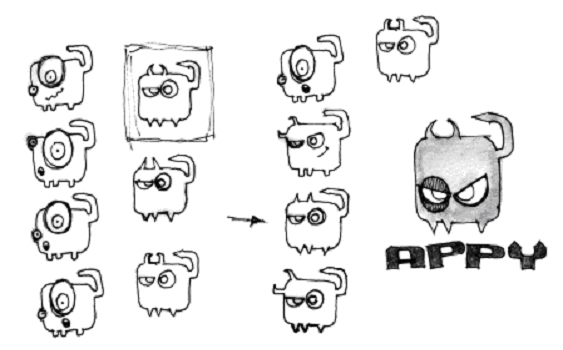
Appy now has three products released into the App Store, not counting demo versions and updates. The first was “Appy Newz,” a sort of pocket Photoshop-Illustrator designed with a single purpose: to quickly create outlandish tabloid newspaper covers using photos of friends. They followed with “Face Fighter,” taking their customization tech and making a game out of it. It’s a pick-up and play fighting game where users import photos to create enemies out of their friends. Their most recent game is “Zombie Pizza,” a puzzle game seeped in Appy attitude and art style. Each app has done better than the last. All three of products have been featured by Apple, something that started with “Face Fighter.”
“Face Fighter was [an Apple] staff pick worldwide. We took off like a rocket. Suddenly we were in the top ten paid apps,” says Paul.
That set off a light bulb for Appy, completely changing the way the company sees its marketplace.
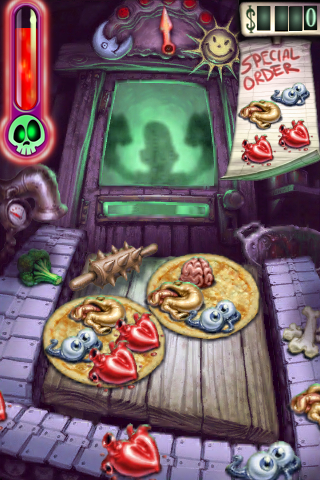 “Zombie Pizza” screen shot
“Zombie Pizza” screen shot
“If Apple doesn’t promote you, you’re in trouble. You have to please Apple or you’re dead. In console games it’s no different, except you had to please Walmart or Target or you’re dead. They were gatekeepers that determined how successful you could be. Apple’s now my most important customer. Everything we do is with Apple in mind. Would Apple want this app on their phone? Would it be featured in an iPhone commercial?”
Last month “Zombie Pizza” had a coup when it was featured in the App Store for four straight weeks, benefiting from being a fresh horror-themed app in time for Halloween. Appy calls it unprecedented coverage by Apple. Sometime during its run, the app ended up getting its own sidebar as the Halloween app recommended by Entertainment Weekly magazine. This week, Appy hit a major milestone when “Face Fighter” reached one million downloads. All of this in just a little over a year after starting up. The studio would have been happy to be an overnight success, catching lightening in a bottle as some have managed to do on iPhone.
“We can be impatient,” says Paul. “Like Carrie Fisher said, the only problem with immediate gratification is that it takes too long.”
Yet the gradual growth is very much part of Appy’s blueprint, with all the parts in place and success now in their sights. As long as Apple keeps noticing.

